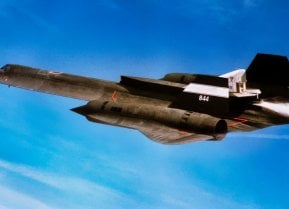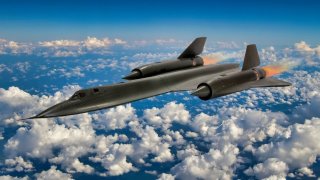Titanium from Russia Was the Secret Ingredient in the SR-71 Blackbird
Able to withstand the hellish temperatures caused by flying at speeds in excess of Mach 3.0, titanium became the perfect solution for the SR-71 Blackbird.
While America’s F-35 Lightning II and China’s Chengdu J-20 fighter jet platforms are widely recognized today as formidable fifth-generation fighters, both airframes are outpaced by a jet that was introduced more than five decades ago. The SR-71 “Blackbird” is perhaps the most notorious Cold War airframe in existence.
Created by Lockheed Martin’s “Skunk Works,” the long-range, high-altitude, strategic reconnaissance fighter could operate at speeds in excess of Mach 3.0 (three times the speed of sound). Comparably, the F-22 Raptor can reach speeds of 2.25 – still a very impressive capability but not quite as speedy as its predecessor.
Besides its unmatched pace, the Blackbird became recognizable for its unique exterior including its black titanium shell. Surprisingly, the U.S. has the Soviet Union to thank for this component.
A brief history of the SR-71 Blackbird
Back in the 1950s, the CIA first approached Lockheed Martin to design an airframe that could operate in the USSR’s airspace without being detected. When a U-2 spy plane was shot down by a surface-to-air missile by the Soviet Air Defense Forces In 1960, the CIA’s inquiry became even more significant. Specifically, the U.S. needed an airframe speedy enough to surpass the Soviet’s interceptors and missiles. Lockheed’s A-12 reconnaissance airframe became the basis for the Blackbird’s design.
Featuring an atypical design that enabled the airframe to fly very quickly, the A-12 was a notable jet. Despite its quick pace, however, the A-12 did have one fatal flaw. The aluminum that framed the airframe was unable to handle the extremely high temperatures created by flying at such fast speeds. In order to deal with this friction issue, American engineers turned to titanium.
How did the U.S. get its hands on Soviet titanium?
Able to withstand the hellish temperatures caused by flying at speeds in excess of Mach 3.0, titanium became the perfect solution for the SR-71 Blackbird. The only issue was that the Soviet Union was the greatest global supplier of titanium during the Cold War. In order to weave around this pretty significant roadblock, the U.S. used Third World countries and fake companies to acquire the amount of titanium needed to design the SR-71 airframes.
According to famous former Blackbird pilot Colonel Rich Graham, “The airplane is 92% titanium inside and out. Back when they were building the airplane the United States didn’t have the ore supplies – an ore called rutile ore. It’s a very sandy soil and it’s only found in very few parts of the world. The major supplier of the ore was the USSR. Working through Third World countries and bogus operations, they were able to get the rutile ore shipped to the United States to build the SR-71.”

Graham told The Aviation Geek Club that one of the fake operations used to procure the Soviet’s titanium was for pizza ovens. The USSR believed the bogus American companies seeking this metal for pizza ovens, providing the SR-71’s engineers with the titanium needed to create the formidable platform.

Unbeknownst to the Soviet Union, the SR-71 Blackbird airframe designed to spy in its own air space could not have been produced without these titanium deliveries. In a way, the SR-71 can in part be attributed to the USSR.
About the Author
Maya Carlin is an analyst with the Center for Security Policy and a former Anna Sobol Levy Fellow at IDC Herzliya in Israel. She has by-lines in many publications, including The National Interest, Jerusalem Post, and Times of Israel. You can follow her on Twitter: @MayaCarlin.
Main image is from Shutterstock. All other images are Creative Commons.


